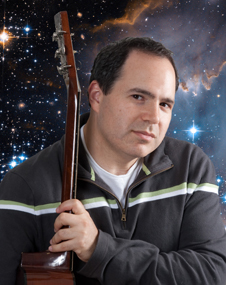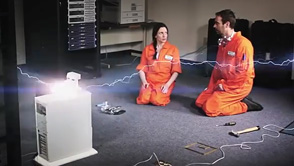
An astronomer is a scientist in the field of astronomy who focuses on a specific question or field outside the scope of Earth. Astronomers observe astronomical objects, such as stars, planets, moons, comets and galaxies – in either observational or theoretical astronomy. Examples of topics or fields astronomers study include planetary science, solar astronomy, the origin or evolution of stars, or the formation of galaxies. A related but distinct subject is physical cosmology, which studies the Universe as a whole.
Infrared astronomy is a sub-discipline of astronomy which specializes in the observation and analysis of astronomical objects using infrared (IR) radiation. The wavelength of infrared light ranges from 0.75 to 300 micrometers, and falls in between visible radiation, which ranges from 380 to 750 nanometers, and submillimeter waves.

The Space Telescope Science Institute (STScI) is the science operations center for the Hubble Space Telescope (HST), science operations and mission operations center for the James Webb Space Telescope (JWST), and science operations center for the Nancy Grace Roman Space Telescope. STScI was established in 1981 as a community-based science center that is operated for NASA by the Association of Universities for Research in Astronomy (AURA). STScI's offices are located on the Johns Hopkins University Homewood Campus and in the Rotunda building in Baltimore, Maryland.

The Atacama Large Millimeter/submillimeter Array (ALMA) is an astronomical interferometer of 66 radio telescopes in the Atacama Desert of northern Chile, which observe electromagnetic radiation at millimeter and submillimeter wavelengths. The array has been constructed on the 5,000 m (16,000 ft) elevation Chajnantor plateau – near the Llano de Chajnantor Observatory and the Atacama Pathfinder Experiment. This location was chosen for its high elevation and low humidity, factors which are crucial to reduce noise and decrease signal attenuation due to Earth's atmosphere. ALMA provides insight on star birth during the early Stelliferous era and detailed imaging of local star and planet formation.
The Max Planck Institute for Extraterrestrial Physics is part of the Max Planck Society, located in Garching, near Munich, Germany. In 1991 the Max Planck Institute for Physics and Astrophysics split up into the Max Planck Institute for Extraterrestrial Physics, the Max Planck Institute for Physics and the Max Planck Institute for Astrophysics. The Max Planck Institute for Extraterrestrial Physics was founded as sub-institute in 1963. The scientific activities of the institute are mostly devoted to astrophysics with telescopes orbiting in space. A large amount of the resources are spent for studying black holes in the Milky Way Galaxy and in the remote universe.

The Indian Astronomical Observatory (IAO) is a high-altitude astronomy station located in Hanle, India and operated by the Indian Institute of Astrophysics. Situated in the Western Himalayas at an elevation of 4,500 meters (14,764 ft), the IAO is one of the world's highest located sites for optical, infrared and gamma-ray telescopes. It is currently the tenth highest optical telescope in the world.

The Balloon-borne Large Aperture Submillimeter Telescope (BLAST) is a submillimeter telescope that hangs from a high-altitude balloon. It has a 2-meter primary mirror that directs light into bolometer arrays operating at 250, 350, and 500 μm. These arrays were developed for the SPIRE instrument on the Herschel Space Observatory. The project is carried out by a multi-university consortium headed by the University of Pennsylvania and which also includes University of Toronto, Brown University, the University of Miami, the University of British Columbia, JPL, INAOE, and Cardiff University. The third flight of BLAST in Antarctica was a scientific success, but much of telescope was destroyed after landing. It has been rebuilt for a flight from Antarctica in the 2010-11 austral summer. This most recent flight of BLAST has a polarimeter to observe the polarized light from star forming cores. The light is polarized due to magnetic fields. It is thought that the magnetic fields inhibit the collapse of the cores. The Herschel Space Observatory does not have a polarimeter.

Mount Graham International Observatory (MGIO) is a division of Steward Observatory, the research arm for the Department of Astronomy at the University of Arizona, in the United States. It is located in southeastern Arizona's Pinaleño Mountains near Mount Graham. During development, it was first called the Columbus Project.

Marc Kuchner is an American astrophysicist, and the Citizen Science Officer at NASA Headquarters. He is known for his work on citizen science, and imaging of disks and exoplanets. Together with Wesley Traub, he invented the band-limited coronagraph, used on the James Webb Space Telescope (JWST), originally designed for the proposed Terrestrial Planet Finder (TPF) telescope. He is also known for his novel supercomputer models of planet-disk interactions and for developing the ideas of ocean planets, carbon planets, and helium planets. Kuchner appears as an expert commentator in the National Geographic television show "Alien Earths" and frequently answers the "Ask Astro" questions in Astronomy Magazine. Kuchner helped found several citizen science projects, including Disk Detective and Backyard Worlds.

Cornelis A. "Neil" Gehrels was an American astrophysicist specializing in the field of gamma-ray astronomy. He was Chief of the Astroparticle Physics Laboratory at NASA's Goddard Space Flight Center (GSFC) from 1995 until his death, and was best known for his work developing the field from early balloon instruments to today's space observatories such as the NASA Swift mission, for which he was the principal investigator. He was leading the WFIRST wide-field infrared telescope forward toward a launch in the mid-2020s. He was a member of the National Academy of Sciences and the American Academy of Arts and Sciences.
The E and B Experiment (EBEX) was an experiment that measured the cosmic microwave background radiation of a part of the sky during two sub-orbital (high-altitude) balloon flights and took large, high-fidelity images of the CMB polarization anisotropies using a telescope which flew at over 42,000 metres (138,000 ft) high. The altitude of the telescope made it possible to reduce the atmospheric absorption of microwaves, which allowed massive cost reduction compared to a satellite probe, however, only a small part of the sky can be scanned and for a shorter duration than a typical satellite mission such as WMAP.

IRrelevant Astronomy is a web series produced by NASA's Spitzer Space Telescope. Each episode explains a general science concept or reveals science news relevant to Spitzer. The "IR" in the title stands for "infrared", making the title refer to "infrared-relevant astronomy." The first episode launched on January 15, 2008, on the Spitzer Space Telescope website.

A balloon-borne telescope is a type of airborne telescope, a sub-orbital astronomical telescope that is suspended below one or more stratospheric balloons, allowing it to be lifted above the lower, dense part of the Earth's atmosphere. This has the advantage of improving the resolution limit of the telescope at a much lower cost than for a space telescope. It also allows observation of frequency bands that are blocked by the atmosphere.

Gerald Jay (Jerry) Fishman is an American research astrophysicist, specializing in gamma-ray astronomy. His research interests also include space and nuclear instrumentation and radiation in space. A native of St. Louis, Missouri, Fishman obtained a B.S. with Honors degree in physics from the University of Missouri in 1965, followed by M.S. and Ph.D. degrees in space science from Rice University in 1968 and 1970, respectively.
Calvin Barth Netterfield, known as Barth Netterfield, is a Canadian astrophysicist, and a Professor in the Department of Astronomy and the Department of Physics at the University of Toronto. He is a leading expert in the development of balloon-borne telescopes. These are astrophysical experiments that are lifted into the stratosphere by high-altitude balloons where they conduct observations that would be hindered by atmospheric interference if done on the ground. Netterfield is primarily known for his work in observational cosmology, specifically in developing instrumentation to observe the cosmic microwave background (CMB) radiation. Most notably, he was a key member of the instrument team for BOOMERANG, the experiment that made one of the first accurate determinations of the age, geometry, and mass-energy content of the universe. More recently, he has delved into the field of submillimetre astronomy and the physics of star formation, through his involvement with the BLAST telescope. Netterfield was featured prominently in BLAST!, a documentary film about the 2005 and 2006 flights of BLAST from Sweden and Antarctica.

The Large Latin American Millimeter Array (LLAMA) is a single-dish 12 m Nasmyth optics antenna which is under construction in the Puna de Atacama desert in the Province of Salta, Argentina, next to the Qubic experiment. The primary mirror accuracy will allow observation from 40 GHz up to 900 GHz. After installation it will be able to join other similar instruments to perform Very Large Base Line Interferometry or to work in standalone mode. Financial support is provided by the Argentinian and Brazilian governments. The total cost of construction, around US$20 million, and operation as well as the telescope time use will be shared equally by the two countries. Construction planning started in July 2014 after the formal signature of an agreement between the main institutions involved.

Violette Impellizzeri is an Italian astronomer, astrophysicist and professor.

Sarah Tuttle is an astrophysicist and assistant professor of astrophysics at the University of Washington. Tuttle builds spectrographs to detect nearby galaxies, including work on VIRUS installed on McDonald Observatory's Hobby–Eberly Telescope to study dark energy, and FIREBall, the world's first fiber fed ultraviolet spectrograph.














